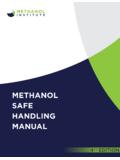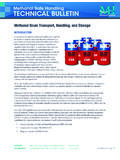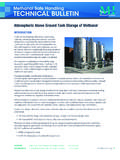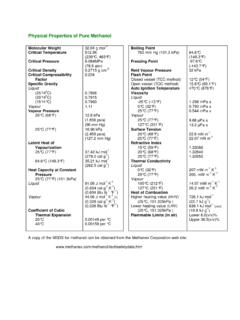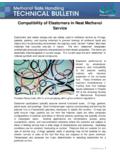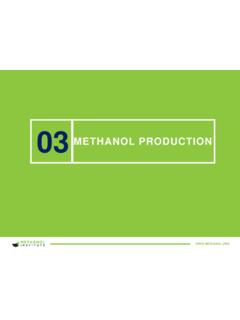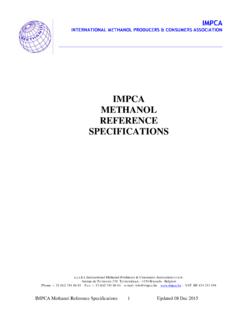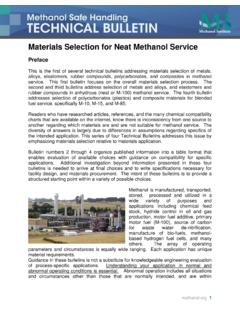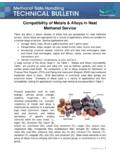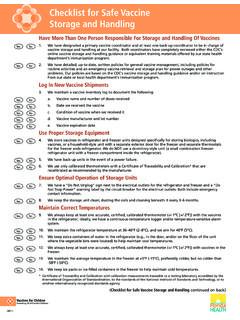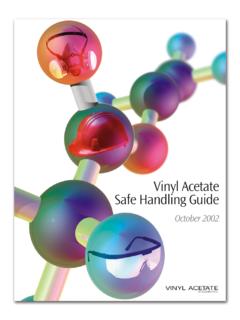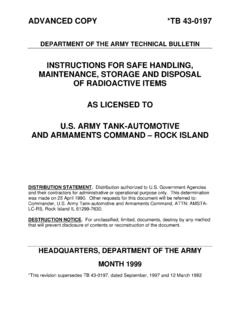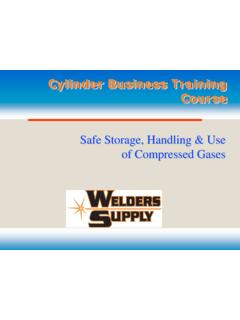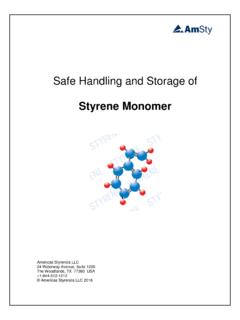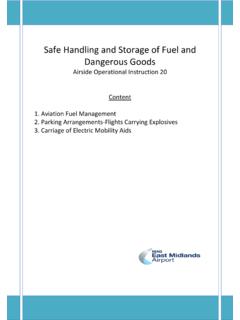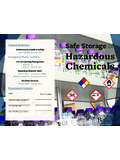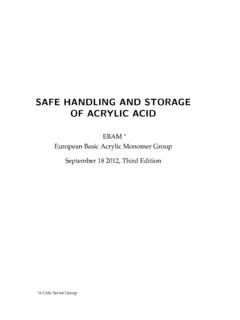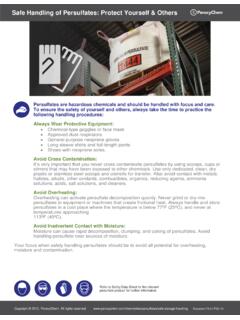Transcription of METHANOL DRUM TRANSPORT, HANDLING, AND STORAGE
1 METHANOL drum transport , handling , AND STORAGE1 METHANOL drum transport , handling , AND INTRODUCTIONT otes, drums (55 gallon), and cans (5 gallon, and 1 gallon) are used to transport , store, and dispense METHANOL in a wide variety of circumstances by low volume users. Non-bulk transport and STORAGE of hazardous material are regulated acti viti es in the and some other countries. Failure to adhere to applicable regulati ons may be punishable by fi nes and imprisonment. Requirements are specifi c to the country and the circumstances; however requirements will generally consist of the following; shipping papers, container labeling, transport vehicle placarding, driver training and licensing, and availability of emergency repines equipment. If you are not a designated hazardous materials carrier, then it may be against the law to transport METHANOL in totes, drums, and not transport METHANOL in your personal vehicle.
2 Do not store METHANOL totes, drums, or cans indoors or in your home. STORAGE requires precauti ons for fl ammable loading, fi re-safe STORAGE , venti lati on, spill containment, spill cleanup, and fi re suppression. Never use mouth sucti on to siphon-transfer METHANOL . METHANOL liquid and vapor are toxic to humans. Exposure is cumulati ve and may result in harm if vapor or liquid are inhaled, ingested, or contacted with skin for extended periods of ti me. METHANOL (CAS: 67-56-1, NIOSH: PC-1400000, DOT: 1230, UN-1230, NA-1230) is classifi ed by the Internati onal Code Council (ICC) and the Nati onal Fire Protecti on Agency (NFPA) under the Uniform Fire Code as a IB Flammable Liquid and by the United Nati ons as a 1993 Class 3 Flammable Liquid. NFPA and Department of Transportati on (DOT) rank Flammability as a 3 primary hazard, and toxicity, as a ranked secondary hazard.
3 Guidelines for handling IB fl ammable liquids are provided by codes and standards published by ICC, NFPA, and the Internati onal Fire Code. ICC and NFPA guidelines are recommended as best practi ces, but are not mandatory unless deemed so by nati onal, or local authority. Within the United States, local authority generally rests with the local Fire Marshal. Mandatory regulati ons have been developed within the United States by the Occupati onal Safety and Health Administrati on (OSHA), an agency of the federal government. Specifi c safe handling practi ces are given under three separate regulati ons for various industries, circumstances, and work environments: General Industry: 29 Code of Federal Regulati ons (CFR) SAFE handling TECHNICAL BULLETINMETHANOL drum transport , handling , AND STORAGE2 Constructi on Industry: Shipyard Industry: ).
4 Guidelines for internati onal transportati on of fl ammable liquids are available from the following bodies: Internati onal Mariti me Organizati on, Internati onal Mariti me Dangerous Goods (IMDG) Code (volumes, 1, 2, and Supplement) Internati onal Air transport Associati on (IATA), Dangerous Goods Regulati ons Intergovernmental Organizati on for Internati onal Carriage by Rail, Regulati ons concerning the Internati onal Carriage of Dangerous Goods by on within the United States is governed by the Department of Transportati on (DOT), an agency of the federal government. DOT regulati ons are available in 49 CFR which can be accessed on the internet or purchased in book format at a nominal cost over the internet. Drums, totes, and cans are transported, stored, and handled by the vast majority of METHANOL users.
5 This discussion focuses on 5-gallon and 55-gallon quanti ti es packaged in metal c containers are not recommended for long-ti me STORAGE or shipment of METHANOL because the solvent properti es of METHANOL may degrade the plasti c, causing the containers to lose structural integrity. STORAGE OF METHANOL -CONTAINING TOTES, DRUMS, AND CANSG uidance for safe STORAGE of METHANOL is provided by ICC, NFPA, and the Internati onal Fire Code. ICC and NFPA guidelines are available in: NFPA 1, Uniform Fire Code NFPA 30, Flammable and Combusti ble Liquids CodeMethanol STORAGE areas should be curbed with a compati ble material such as concrete, venti lated to prevent accumulati on of vapors, and drained to a safe locati on which is remote from the STORAGE area. STORAGE areas should be equipped with vapor, and heat detector/alarms.
6 Because METHANOL burns with a transparent, non-luminous blue fl ame, combusti on will likely not be detected by standard smoke detectors, and luminous-type fl ame detectors. Carbon monoxide and carbon dioxide detectors may serve in place of smoke detectors and luminous fl ame detectors. First responders use infra-red detecti on methods to determine if combusti on is occurring. It is recommended that this type of detector be installed and alarmed to monitor METHANOL tote, drum , and can STORAGE areas. Detecti on should be redundant with detectors positi oned at right angles to one more than several drums are stored, then considerati on should be given to automati c fi re suppression using either fi ne water mist spray, or alcohol resistant fi re-fi ghti ng foam (AR-FFF).
7 STORAGE of multi ple containers is subject to limitati ons on stacking height, and container density loading. Refer to the listed codes to obtain guidance, which is specifi c to your and drum containers must be stored outside, not within a structure, unless placed in a liquid STORAGE room or warehouse meeti ng the requirements for fl ammable liquids STORAGE buildings. Five-gallon and 1-gallon containers may be stored within a building provided they are contained in a fi re-safe cabinet which is grounded, and vented to an outside safe locati on which includes an explosion suppression drum transport , handling , AND STORAGE3 SHIPMENT OF TOTES, DRUMS, 5-GALLON CANS, AND 1-GALLON CONTAINERSG uidance for shipment of METHANOL via the Postal Service is contained in United States Postal Service Publi-cati on 52, 343 Flammable and Combusti ble Liquids (Hazard Class 3).
8 Transportati on of drum quanti ti es (8 to 119 gallon quanti ti es of METHANOL ) is regulated by multi ple agencies and organizati ons. The regulatory authority depends on: Method of transport (truck, rail, air, or sea-going vessel). Capacity of individual containers, the number of containers which comprise a single shipment. Whether shipment is domesti c within territory or outside of controlled territory. Shipping oversight is the responsibility of the following regulatory bodies: Within the United States, the Department of Transportati on (DOT), Hazardous Material Regulati ons 49 CFR 100-199 and Emergency Response Guide Book United Nati ons Locati on Codes (UN/LOCODES), UN Recommendati ons on transport of Dangerous Goods ( , the so-called UN-Orange Book) Internati onal Mariti me Organizati on (IMO), Internati onal Mariti me Dangerous Goods Code (IMDG), Volumes 1 and 2, plus a supplement Internati onal Civil Aviati on Organizati on (ICAO).
9 Technical Instructi ons for the Safe transport of Danger-ous Goods by Air Internati onal Air Transportati on Associati on (IATA), Dangerous Goods Regulati ons (DGR) Road, rail, airborne, and water transport of hazardous materials is controlled by DOT for goods shipped within the United States. Regulatory revisions are made almost conti nuously; verify that you are using current versions of the regulati restricts aircraft transportati on of Class 3 fl ammables ( , METHANOL ) to a maximum of 1 liter on passenger aircraft and 60 liters on cargo aircraft , irrespecti ve of the shipping company: Fed-X, UPS, etc. drum quanti ti es are not considered to be air transportable. Refer to , Hazardous Materials Table for specifi c informati on regarding shipment of METHANOL .
10 Refer to for non-bulk packaging requirements on passenger and cargo aircraft . CONTAINER SPECIFICATIONS FOR TRANSPORTING AND STORING METHANOLC lass IB Flammable Liquids are equivalent to DOT-designated PG II Flammable Liquids. Non-bulk volumes of PG II Flammable Liquids between 8 and 119 gallons are required to be packaged in DOT performance-oriented packaging identi fi ed using the United Nati ons identi fi cati on system. Specifi cati ons for drums are established and published by Oak Ridge Nati onal Laboratory. A copy of these specifi cati ons can be obtained by contacti ng Oak Ridge Nati onal Laboratory, Packaging Operati ons Manager, Bldg. 7001, MS 6288 Box 2008, 1 Bethel Valley Road Oak Ridge, Tennessee 37831-6288. Totes, drums, and cans are available which just meet, and which ex-ceed published specifi cati ons.
